One home I lived in was spider infested. Sometimes at night, while watching television in the den, I would see a very large brown spider cross the carpet right in front of me. It wasn’t a once in a while thing; it was more like a once a night thing. Somewhere in my home, the spiders were entering and staying. At the time, the only way I knew to get rid of the infestation was to call an exterminator. So, I did. Now, in a different home, I don’t have a spider infestation, but I do get occasional unwanted spiders that I’m able to deal with myself. Did you know there are easy, cheap, and natural ways to get rid of spiders, using stuff you already have in your home? Here’s how.
Clear Out Clutter and Cardboard
Begin by cleaning out all the clutter in and around your home, your basement, attic, and porch. Put away all toys and unnecessary odds-and-ends into plastic tubs with lids. Remove or seal in plastic, all piles of clothing or fabrics that spiders could crawl into. One of the best de-cluttering tip you could do is to get rid of cardboard boxes. Spiders are drawn to wood and wood products. The same thing goes for wood bark outside your home. Be sure you have no bark bumping up against the home, or you will be giving an open invitation to spiders in your home. The exception is cedar bark. It might actually offer you an advantage against spiders.
Seal Up Holes and Cracks
The next spider-ridding tip is to seal up any holes or cracks in the exterior walls of your home through which a spider might enter. That’s how I got so many spiders in my previous home. An inadequately built addition had been added onto the home. I could feel a slight breeze on my face when I stood in the door jam of the pocket door. I’m certain that spiders came inside from right there.
Eliminate the Vegetation
Another situation I had at my previous home, that I don’t have in my current one, was much vegetation growing next to the house. It was an older home with mature shrubs, bushes, and trees growing close to the house. Spiders love that. You really don’t want shrubs next to your exterior walls, especially climbing ivy. Spiders eat insects that live in or eat vegetation.
Eliminate Other Food Sources
When the heat of summer begins to present hot temperatures, spiders seek to move indoors out of the heat and where there’s water. That’s why spiders will gather in the bathroom or kitchen. Another place spiders find food and water is at the dog bowl. It may be a good idea to cover the dog bowl except when you feed the dog. But then, some dogs and cats will help rid your home of any spiders they can catch, one spider at a time.
Sweep, Spray, and Turn Out Lights
Indoors and outdoors, it’s a good idea to sweep down any cobwebs. Remove the web, and the spider moves on. Use a broom under the eves, or use power-washer. In addition, you’ll want to keep porch lights off as much as possible, since light attracts bugs that attract spiders. Finally, move garbage cans away from your house. Garbage attracts insects that attract spiders.
Use Natural, Non-Toxic, Easy, Cheap Techniques
In addition to the above spider-prevention techniques, there are also some natural, non-toxic, easy, and cheap techniques that can help rid your home of spiders. Here are some of the natural techniques folks use to get rid of spiders from in and around their homes.
1. Vacuum the spiders, if you’re fast enough.
2. Use the glass jar and paper catch-and-release method.
3. Sprinkle baking soda along the floorboards.
4. Spray soapy water under the eaves and along the house.
5. Scatter cotton balls doused with eucalyptus oil, lemon oil, or rubbing alcohol.
6. Borax sprinkled along the floorboards works too, but may not be safe for children or pets.
Spiders go where there’s a food source. Knock out their food source, and you knock out your spider problem. If however, you’re dealing with a spider infestation–particularly dangerous spiders–it’s best to call in a professional. If spiders are more of a nuisance, you can help rid your home of spiders using the cheaper, non-toxic methods.
Reference:
- www.associatedcontent.com/article/995068/how_to_know_if_your_home_has_mold.html?cat=5
- www.associatedcontent.com/article/1677073/grass_clippings_as_garden_mulch_pros.html?c
